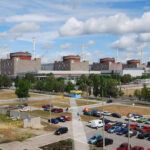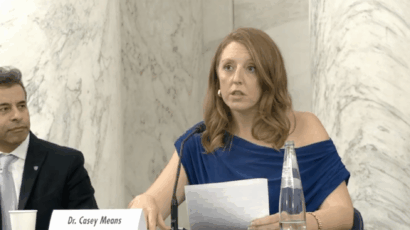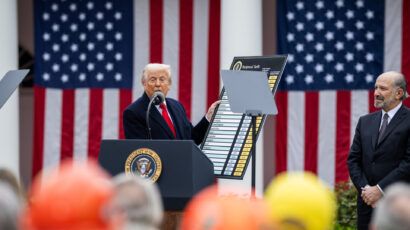The coming German energy turnaround
By Claudia Kemfert | September 7, 2011
Following the terrible catastrophe at Fukushima, Germany’s government has decided to usher in a sustainable energy turnaround that entails switching off all of the country’s nuclear power plants by the year 2022. In the spring of 2011, in fact, eight nuclear power plants were immediately and irreversibly taken off line. The nuclear phase-out is not fundamentally new; in principle, Angela Merkel’s Christian Democratic Union government is re-adopting the policies of the previous “red-green” Social Democrat-Green Party coalition.
But a successful energy turnaround — one that provides sufficient electricity, holds climate-damaging carbon emissions in check, and limits electric-price increases — involves much more than shutting down nuclear power plants. There is, first, the problem of fuel mix. More than 40 percent of electricity in Germany is generated from coal, and roughly half of Germany’s coal-fired power plants are scheduled to be taken off line by 2022 due to old age. With a decline in nuclear power generation, the coal-fired segment of Germany’s energy supply threatens to increase unless an ambitious alternative energy plan is followed.
Any plan that aggressively supports expansion in the renewable sector and replaces decommissioned coal-fired plants with natural gas power stations will be expensive. Total investment over the next decade for such an energy turnaround is estimated to be roughly €200 billion (or almost $290 billion). There is good news connected to that estimate, however. The investment can come mostly from private sources, with only a partial subsidy by government. And the German Institute of Economic Research calculates that electricity prices will rise only slightly as a result of the energy turnaround, giving existing businesses little incentive to move production outside the country and potentially creating hundreds of thousands of jobs in the German renewable-energy and sustainability sectors.
Of course, not all the energy news out of Germany is good, or clean. At the moment, more than 20 new coal-fired power plants are being planned or already under construction; together, they would achieve a total output of 10 gigawatts and could, in terms of power supply, replace nuclear power plants that are still operational. But coal-fired power plants do not fit into the concept of the sustainable energy turnaround that the government has put forward. They produce far more climate-endangering greenhouse gases than other sources of energy — for example, double the amount that natural gas produces.
Gas-fired power plants would be far more suitable for the transition period. They are less emission intensive and more easily combined with fluctuating renewable energy sources like wind and solar, because gas systems can be powered up and shut down quickly. Also, there is an overabundance of gas in the international market, and prices are accordingly low. (The price of gas is comparatively high in Germany because it is still tied strongly to the price of oil. Sooner or later, however, international developments will bring down Germany’s gas price.)
Whether coal becomes a declining source of German electricity in coming decades, however, will depend on the success of the government’s plans to greatly increase renewable energy production. The goal is to increase the renewable share of the energy mix from today’s 17 percent to 80 percent within the next four decades. The goal is feasible in principle. Such a transformation, however, would require vastly expanded electrical grids and more energy storage facilities — for example, the so-called pumped storage plants that move water to higher levels for later hydroelectric generation and that are already being used in Germany and Scandinavia. New forms of energy storage that are currently in development may also become part of the German system. For example, batteries in electric vehicles can be used as storage units when they simultaneously make use of the “vehicle to grid” option, i.e. when they feed stored power back into the grid. Such a program, however, would require a rebuilding of infrastructure to allow a “smart” electrical distribution system. New fuels may also help store energy in different forms. At peak periods of renewable energy generation, excess electricity could be used to produce hydrogen or methane, which could then be used to power cars and trucks.
In making the energy transformation, demand is just as important as supply, and both the mobility property sectors have large potentials for efficiency savings. For example, almost a fifth of the energy requirements of buildings could be met by making use of efficient insulation and air conditioning.
So an energy turnaround that eliminates nuclear power plants and limits carbon dioxide emissions is technically possible in Germany. But does such a turnaround make economic sense, or is Germany isolating itself economically? Is there danger of a deindustrialisation — that is, will businesses relocate because of exploding electricity prices — and will Germans have to live with blackouts? Some with political or financial interests in the status quo like to predict horrific economic effects from an energy turnaround, but a close look at German energy prospects suggests the opposite is true: There will be no blackouts if there is sufficient investment in expanded electric grids and, in the short term, new fossil power plants, whether coal- or gas-fired. Electricity prices will rise only moderately, because factors that push prices higher and lower will tend to cancel one another. And the important industries that supply the products necessary for renewable energy and sustainable transportation to succeed will profit greatly from an energy turnaround. The chemical industry, for one example, delivers energy-efficient products needed by both the transportation and property sectors. And the list of industries that will prosper as a result of the turnaround is a long one.
Yet the question does remain: Who will pay for this energy turnaround? Initial investments will have to largely come from businesses, with partial financing by the public sector. The public financing part of the equation seems to have a workable funding mechanism. A newly established climate fund for financing sustainable energy, for example, will be fed by monies generated by the sale of certificates that allow the emission of carbon dioxide, part of the European Union’s carbon-trading regime. If nuclear power were to be replaced by coal-fired plants, carbon dioxide emission costs would rise, resulting in increased assets in the climate fund, which could then be used to support alternative energy. Gas-fired plants would produce lower, but still significant, carbon dioxide revenue increases.
The effects of changes in Germany’s energy landscape will push electricity prices in both directions simultaneously; that’s to say, there are as many price-raising factors as price-lowering ones in the conversion to more renewable energies. As nuclear plants are shuttered, the price of electricity at the stock exchange will lead to price increases, thanks to a decrease in supply. The costs of expanding electrical grids to serve alternative energy sources will also slightly increase prices, although the magnitude will be fairly limited. When nuclear is replaced by coal, the price of emitting carbon dioxide will go up, and this also raises electricity prices. On the other hand, the exploitation of renewable energies will bring down overall electricity prices, since, as a function of how they are calculated, feed-in tariffs will decrease when the wholesale price of electricity increases. Imports of electricity will also have a price-lowering effect, since electricity is cheaper in neighboring countries. Increased competition could have a price-lowering effect, as well. In the end, electricity prices will likely rise slightly, in the range of 1.4 to 1.6 cents per kilowatt hour, according to the German Institute of Economic Research.
Still, it is clear that a German energy turnaround will require huge investments. If the percentage of renewable energies is to be doubled, up to €122 billion will have to be invested in this sector in the next 10 years, according to an estimate by the German Federal Environment Ministry. The Federal Network Agency estimates that up to €25 billion will be needed to expand the electrical grid in the next 15 years. Up to €3.5 billion in subsidies will be needed for the energy-efficient renovation of buildings. Up to €15 billion need to be invested — by private investors, municipal energy suppliers, and infrastructure and energy businesses — for additional gas-fired power plant capacities. (Due to rising carbon dioxide prices, coal-fired power plants will likely become less attractive over time, economically speaking.) In total, investments of almost €200 billion will be required in the next 10 years.
So enormous investments are necessary as a result of the nuclear phase-out, and at the beginning of the German energy turnaround, electricity-production costs of renewable sources will be relatively high compared to conventional energy. But these investments will create value and hundreds of thousands of jobs related to new power plants, energy efficiency programs, the construction of sustainable buildings, and the implementation of greener transport systems. The German energy turnaround not only leads to a sustainable energy supply, it clearly offers more opportunities than risks.
Together, we make the world safer.
The Bulletin elevates expert voices above the noise. But as an independent nonprofit organization, our operations depend on the support of readers like you. Help us continue to deliver quality journalism that holds leaders accountable. Your support of our work at any level is important. In return, we promise our coverage will be understandable, influential, vigilant, solution-oriented, and fair-minded. Together we can make a difference.
Topics: Climate Change, Nuclear Energy, Opinion















